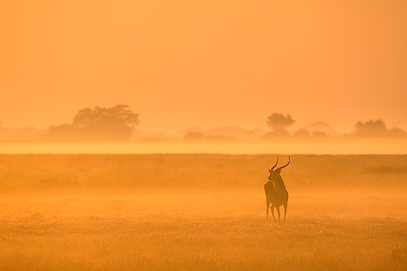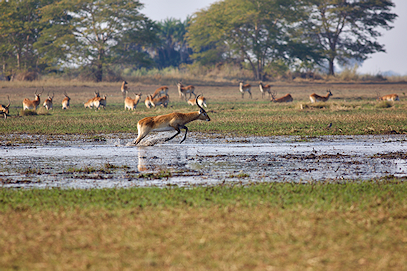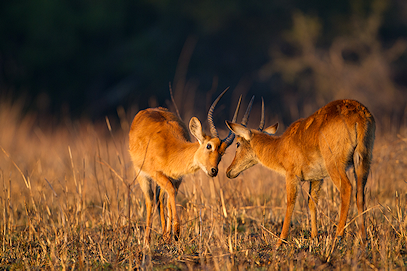Zambia's Kafue National Park
Help Me Plan- Home
- >
- African Travel
- >
- Zambia
- >
- Kafue National Park
Kafue National Park Destination Guide
Kafue is Zambia’s oldest and largest national park, a vast wilderness of miombo woodland, open grassland and seasonal floodplains along the Kafue River. Its Busanga Plains and riverine habitats support notable predators, especially leopard and lion, plus specialized antelope such as puku, red lechwe and Lichtenstein’s hartebeest, and outstanding, diverse birdlife.
Getting to Kafue National Park
By Air: Guests are met on arrival at O R Tambo International Airport in Johannesburg and assisted with transferring to an international flight to Lusaka. From Lusaka, guests connect to a light aircraft to Kafue National Park in north-western Zambia. A camp ranger will drive you to camp from the resident airstrip in a 4x4 vehicle.
Weather & Best Times to Visit
The weather plays an integral part in visiting Kafue. During the wetter summer season from November to April the plains are flooded, which makes a large part of the park inaccessible. The wet season transforms the area and its lush greenery is spectacular to see. Some camps remain open year-round.
The best time to visit is during the dry season from June to October, when most of the park is accessible. The park is fairly large, and climate varies by area; some parts can drop below freezing in winter. The dry season is also the best time for game viewing, and boat cruises are available throughout the year as well.

The Kafue River and its floodplain are well known for rich birdlife, with over 500 species recorded. Busanga Plains, part of Kafue, is a vast floodplain fed by the Lufupa River. When the floodwaters recede, fresh grass attracts large herds of zebra, wildebeest and other antelope.
Reasons to visit Kafue National Park
Off the Beaten Track
Standing in a queue of cars to view wildlife can be frustrating. In Kafue, this is rare. It is one of the few places where the untouched natural beauty of wild Africa can still be experienced and appreciated. Here you can revel in solitude and reconnect with nature.
Lake Itezhi-Tezhi
Although artificial, Itezhi-Tezhi Lake is one of the most striking features of the Kafue landscape. At roughly 370 km², it is almost the size of the island nation of Grenada. Its vastness is set against the scale of the 22 400 km² conservation area.
Birdwatching
More than 480 bird species occur in Kafue, so remember to pack binoculars — you will be using them often. Pel’s fishing owl, bee-eaters, kingfishers, African finfoot, goliath heron, wattled crane, hornbill, vulture, eagle and more breed in the park’s wetlands.
Experiences to Savor
When exploring Zambia's Kafue National Park, you'll savor the low visitor density and the prolific animal population. The immense herds and the predators that trail them are a highlight.

Far from the madding crowd
When visiting Kafue, you can experience nature in a pure, unspoiled state. You can go on a game drive without viewing another vehicle. There is limited or no mobile signal, television or other distractions — just you and wild Africa.
Nothing Plain about it
The Busanga Plains are among the jewels of Kafue and Africa. The immense beauty and diversity of these wetlands are hard to articulate. The river and its offshoots create a water-logged web that fascinates throughout a stay.
Goodness grazing!
The floodplains create ideal grazing for antelope such as red lechwe and puku. Buffalo, wildebeest, elephant and large herds of lechwe forage in the grasses — and predators follow.Useful Information
History
The area was protected as a reserve in 1924. In April 1950, the status was upgraded to a national park by the Governor of Northern Rhodesia. In the 1950s, the authorities began developing park infrastructure.
Infrastructure was required to provide visitors access to the area’s natural wealth. Surveying boundaries and roads and clearing sites for camps got underway. Authorities built airstrips and camps. After consultation with chiefs, the relocation of villagers out of the national park concluded in the 1960s. With permits, villagers were allowed to fish seasonally, harvest wood for fuel and building, pick fruit for sustenance and gather salt from the pans.
Wildlife
Kafue contains four of the Big Five, excluding the rhinoceros. Leopard are often encountered in forested areas. Large prides of lion, up to 20 strong, move throughout the reserve, and cheetah are found especially in the north. Kafue is also a stronghold for the endangered African wild dog. Although wild dog are never easy to see, Kafue provides a strong chance because the Greater Kafue ecosystem holds one of Zambia’s largest populations.
Elephant are abundant. The Kafue River and its tributaries contain large pods of hippo and some of the largest crocodile in Southern Africa. You will encounter herds of puku and red lechwe. Elusive species like blue duiker, yellow-backed duiker, sitatunga, roan and sable are regularly recorded. Other mammals include pangolin, aardvark, bushbaby, honey badger and more. It is a birder’s paradise, with over 500 species documented, including Zambia’s endemic Zambian barbet.
Vegetation & Terrain
Kafue is both the oldest and biggest national park in Zambia. The area is predominantly covered by miombo woodland, grassland and shrubland, although wooded grasslands, riparian forests and acacia woodland occur. Northern Kafue is known as the Busanga Plains: a rolling plateau of miombo woodland, mopane woodland and grassy dambos (shallow wetlands) in places. The area is veined by many tributaries of the Kafue River, which in turn create corridors of hardwood riverine forest, navigable by dugout canoes during the rainy season.
The park includes various wetlands, such as the Busanga Swamps in the far north-western region, the Kafue Flats, Lukanga and Lushwishi swamps, listed as wetlands of international importance under the Ramsar Convention. These lush areas and the variety of ecosystems are critical to the animals they support. Sycamore fig and baobab are prominent and culturally significant in the area.
Activities
A variety of safari opportunities are available. Birding safaris are popular in Kafue, and specialist birding drives accompanied by expert rangers are available. Day and night drives in 4x4 vehicles are an excellent way to view larger animals and cover more ground. Walking safaris offer a more hands-on way to experience the terrain. During the rainy season, safaris on the Kafue River using dugout canoes are a unique way to explore the surroundings.
At certain times of year, hot-air ballooning is available in the park, offering a breathtaking aerial view of the grasslands, wetlands and larger animals roaming the rolling plains. Sunrises and sunsets across this African safari are spectacular, and the area offers superb opportunities for photographers and cinematographers. Fishing is also allowed in the park; African pike and barbel are regularly caught off the banks of the Kafue River and its channels. At night, lie back and admire a sky crowded with stars.









